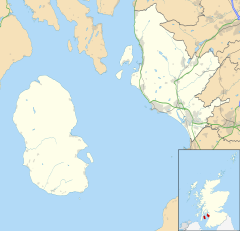
Back Örvin Azerbaijani اروین (ایسکاتلند) AZB Ървин Bulgarian Irbhinn Breton Irvine (North Ayrshire) Catalan Irvine (kapital sa dapit sa konseho sa Hiniusang Gingharian) CEB Irvine (Skotsko) Czech Irvine, Gogledd Swydd Ayr Welsh Irvine (Skotland) Danish Irvine (Schottland) German
Irvine
| |
|---|---|
| Administrative centre and new town | |
 Coat of Arms of Irvine | |
Location within North Ayrshire | |
| Population | 34,130 (2022)[1] |
| OS grid reference | NS325395 |
| • Edinburgh | 77.7 mi |
| • London | 430.9 mi |
| Community council |
|
| Council area | |
| Lieutenancy area | |
| Country | Scotland |
| Sovereign state | United Kingdom |
| Post town | IRVINE |
| Postcode district | KA11 – KA12 |
| Dialling code | 01294 |
| Police | Scotland |
| Fire | Scottish |
| Ambulance | Scottish |
| UK Parliament | |
| Scottish Parliament | |
Irvine (/ˈɜːrvɪn/ UR-vin; Scots: Irvin[2] [ˈɪrvɪn]; Scottish Gaelic: Irbhinn [ˈiɾʲivɪɲ])[3] is a town and former royal burgh on the coast of the Firth of Clyde in North Ayrshire, Scotland. The 2011 Census recorded the town's population at 33,698 inhabitants, making it the largest settlement in North Ayrshire, [4] and 22nd largest settlement in Scotland.
Irvine was designated at the fifth and final Scottish new town in November 1966.[5] Irvine is the administrative centre and the seat of the North Ayrshire Council administration which has its headquarters based at Cunninghame House. Irvine was the site of Scotland's 12th century military capital and former headquarters of the Lord High Constable of Scotland, Hugh de Morville.[6] It also served as the capital of Cunninghame and was, at the time of David I, Robert II and Robert III, one of the earliest capitals of Scotland.[7]
The town was once a haunt of Robert Burns, after whom two streets in the town are named: Burns Street and Burns Crescent. He is known to have worked in a flax mill on the Glasgow Vennel. Despite being classed as a new town, Irvine has had a long history stretching back many centuries and was classed as a Royal Burgh. There are also conflicting rumours that Mary, Queen of Scots, stayed briefly at Seagate Castle. There is still a yearly festival, called Marymass, held in the town. Marymass refers to Mary Queen of Scots and is celebrated for around a week starting from the 15th of August, and was therefore Mary's Mass hence Marymass.
- ^ "Mid-2020 Population Estimates for Settlements and Localities in Scotland". National Records of Scotland. 31 March 2022. Retrieved 31 March 2022.
- ^ List of railway station names in English, Scots and Gaelic – NewsNetScotland Archived 22 January 2013 at the Wayback Machine
- ^ "Stòr-data". Gaelicplacenames.org. Archived from the original on 29 November 2014. Retrieved 11 November 2017.
- ^ "Irvine Area Profile – 2011 Census". Scotland's Census. Retrieved 5 October 2015.
- ^ "Irvine". Town and Country Planning Association. Retrieved 4 May 2024.
- ^ Morton, pp. 2–4
- ^ Morton, pp. 2–10





